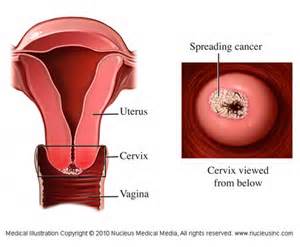By Eronie Kamukama
When some people hear the words cervical cancer, all that they understand is that it is that cancer that attacks the cervix, a tissue at the opening of the uterus.
Some people do not have any idea of what it is yet according to doctors, it is the number one killing disease among people who suffer from cancer in Uganda.
In developing countries, it is the second most common cancer among women. Among ordinary citizens, little or nothing is known about the disease yet it continues to claim so many female lives.
What is Cervical cancer?
Cervical cancer is the abnormal growth of cells on the cervix, also known as the mouth of the uterus. This means that it only occurs among women.
According to Dr. Lawrence Kazibwe, a gynaecologist at Abii Clinic in Wandegeya, cervical cancer is majorly caused by HPV, a virus known as Human Papilloma Virus.
He says this virus lives under the foreskin of a man’s penis and is acquired through sexual intercourse with an HPV carrier.
Who is prone to cervical cancer?
Kazibwe explains that people who have multiple sexual partners are very prone to acquiring the disease. There are other risk factors that play a great role.
- Sexual intercourse with a woman who has the cancer, he is likely to acquire the virus which he might pass on to another woman
- HIV positive women due to low immunity
- A man whose wife has died from cervical cancer
- Having unprotected sex or poor condom use
According to Dr. Pascal Kalanguka at Rita Health Care Services, early sex especially among people under the age of 21 years, exposes someone to a 1.5% risk of acquiring the cancer.
Prevalence rate for Cervical Cancer in Uganda
According to the Strategic Plan for Cervical Cancer Prevention and Control in Uganda in 2010, the incidence rate for cervical cancer in Uganda is 45.6 per 100, 000 women. It accounts for 40 percent of all cancers recorded in the Kampala Cancer Registry.
Signs and Symptoms
Kazibwe explains that cervical cancer develops at different rates depending on the person who has acquired the virus. For some women, it takes approximately 5 to 15 years for the cancer to show symptoms.
For women who are HIV positive, it takes about five years for the symptoms of the cancer to show because their immunity to fight the disease is low, hence quick development.
Kazibwe says the symptoms vary according to the stages of the cancer.
During the early stages, it is likely that the patient will not experience any symptoms. However, in the late stages of cervical cancer, the woman’s vaginal discharge becomes watery, smelly and its color ranges from dirty yellow to blood stained discharge
The signs continue to show if not medical treatment is availed.
- Contact bleeding when the cervix is touched during bathing or even during sex
- Dull back pain
- Passing urine that has blood
- Difficult when passing stool
Prevention
The Ugandan government is currently promoting vaccination to prevent the disease. Kalanguka urges the use of vaccination saying that all girls between 11 and 12 years can benefit from Gardasil and Cerviscil vaccines. He cautions parents to have their children vaccinated because it reduces their chances of getting the virus.
 Like most diseases, cervical cancer is treatable and can be cured. The most important first step is finding out whether a woman has the cancer and this is done through screening.
Like most diseases, cervical cancer is treatable and can be cured. The most important first step is finding out whether a woman has the cancer and this is done through screening.
Kazibwe says women should go for pre-cancer screening because if the disease is detected early, it is easier to treat and cure completely.
Women who are over 20 years old and are sexually active are cautioned to go for the screening.
He notes that HIV positive women should do checkups at least once a year and those who are HIV negative should test every after three years.
Treatment
Kalanguka explains that once the disease is detected, the doctor can freeze the abnormal cells until they peel off and fall off the cervix.
In some instances, the doctor can carry out surgery to permanently remove the uterus and cervix where the cancerous cells are growing. This only applies to situations when the cancer is in its early stages.
 Kalanguka explains that once the cancer is in its advanced stages and the doctor has established that it has already spread to other tissues of the body, he can only offer palliative radiotherapy and use morphine which help to reduce the patient’s pain.
Kalanguka explains that once the cancer is in its advanced stages and the doctor has established that it has already spread to other tissues of the body, he can only offer palliative radiotherapy and use morphine which help to reduce the patient’s pain.
Challenges in the fight against cervical cancer
Kalanguka observes that many women in Uganda are ignorant about cervical cancer and there are very few health workers in Uganda who encourage women to go for cancer screening.
He says, “a study carried out shows that most workers in the maternal wards do not encourage women to go for checkups which is why we had more people dying from cervical cancer than from road accidents,” Kalanguka says.
He adds that the lack of PAP smears in hospitals and histologists who analyze tissue and tell whether it has cancerous cells are all reasons as to why the disease continues to silently kill women.
Kazibwe says the vaccines for cervical cancer too expensive for many people to afford. The vaccines cost between 200,000 shillings and 400,000 shillings.
Recommendations
However, Kalanguka says despite these hindrances, the Ugandan government should aim at educating women on cancer prevention.
He says the most important step in the fight against cervical cancer related deaths is to prevent its spread and reduce the risk factors. “Emphasis should be put on raising awareness and educating the masses on the risk factors to reduce exposure to the virus.
Women should strive to stay HIV free and young girls should delay sex,” Kalanguka says.